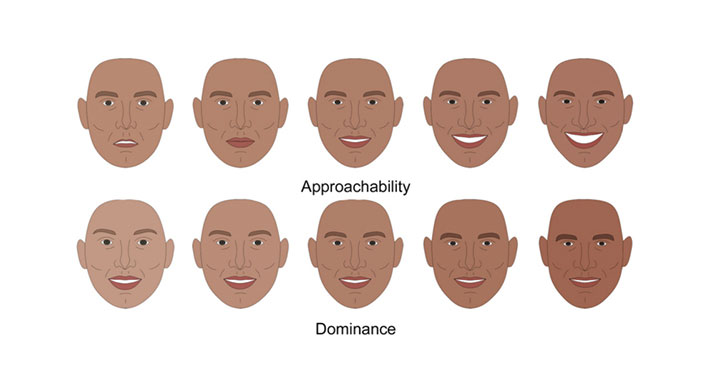A study by researchers in our Department of Psychology shows how rapidly formed first impressions that influence our subsequent behaviour towards that person can be accurately predicted based on the physical features found in everyday images of faces, such as those found on social media. The impressions we create through such images are important in a world where we increasingly get to know one another online rather than in the flesh.
Our judgments fall into three distinct dimensions:
- Approachability – do they want to help or harm me?
- Dominance – can they help or harm me?
- Youthful-attractiveness – would they be a good romantic partner – or rival
Physical features
To investigate the basis for these judgments the research team took ordinary photographs from the web and analysed physical features of the faces. Each of 1,000 faces was described in terms of 65 different features such as 'eye height' or 'eyebrow width'.
The researchers developed a computer model that could accurately predict people’s first impressions based only on these features.
Reversing the process, it was also possible to create new cartoon-like faces that produced predictable first impressions in a new set of judges.
The study, published in Proceedings of the National Academy of Science (PNAS), shows how specific images of faces can create favourable or unfavourable first impressions. It provides a scientific insight into the processes that underlie these judgments and perhaps into the instinctive expertise of those (such as casting directors, portrait photographers, picture editors and animators) who create and manipulate these impressions professionally.
Richard Vernon, a PhD student who was part of the research team, said: “Showing that even supposedly arbitrary features in a face can influence people's perceptions suggests that careful choice of a photo could make (or break) others’ first impressions of you.”
Intuition
Fellow PhD student, Clare Sutherland, said: “We make first impressions of others so intuitively that it seems effortless - I think it's fascinating that we can pin this down with scientific models. I'm now looking at how these first impressions might change depending on different cultural or gender groups of perceivers or faces.”
Professor Andy Young, of the Department of Psychology at York, said: “Showing how these first impressions can be captured from very variable images of faces offers insight into how our brains achieve this seemingly remarkable perceptual feat.”
Dr Tom Hartley, who led the research with Professor Young, added: “In everyday life I am not conscious of the way faces and pictures of faces are influencing the way I interact with people. Whether in “real life” or online; it feels as if a person’s character is something I can just sense. These results show how heavily these impressions are influenced by visual features of the face - it’s quite an eye opener!”
The text of this article is licensed under a Creative Commons Licence. You're free to republish it, as long as you link back to this page and credit us.






